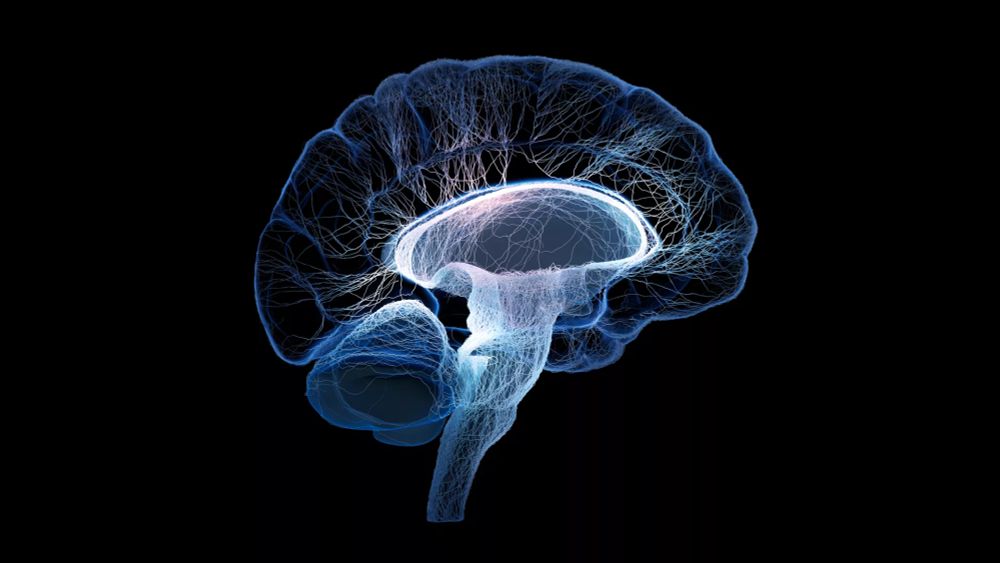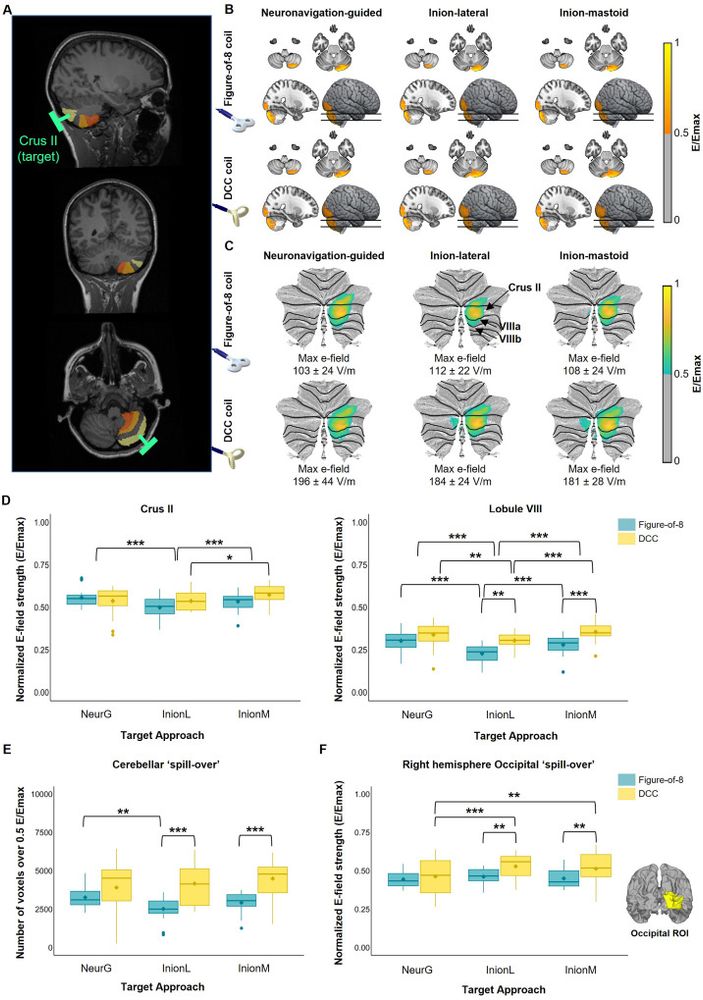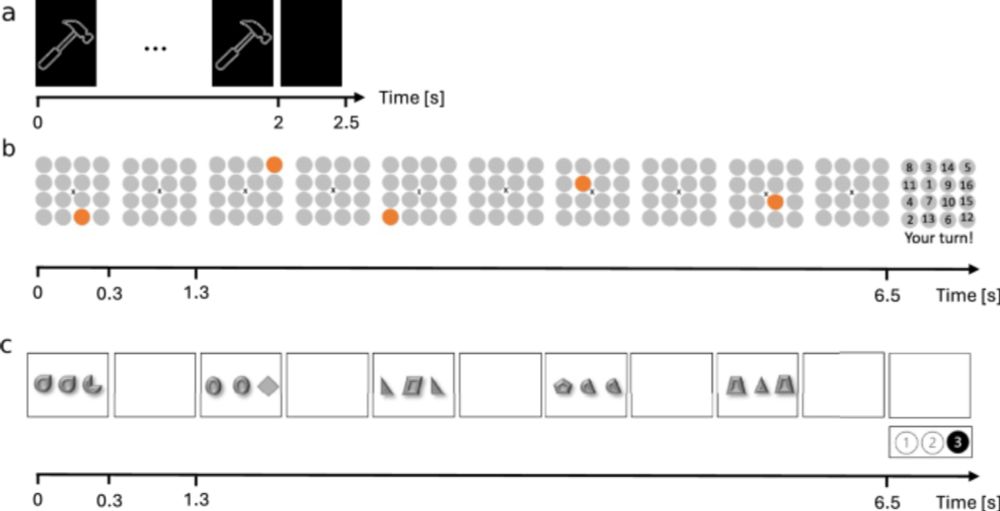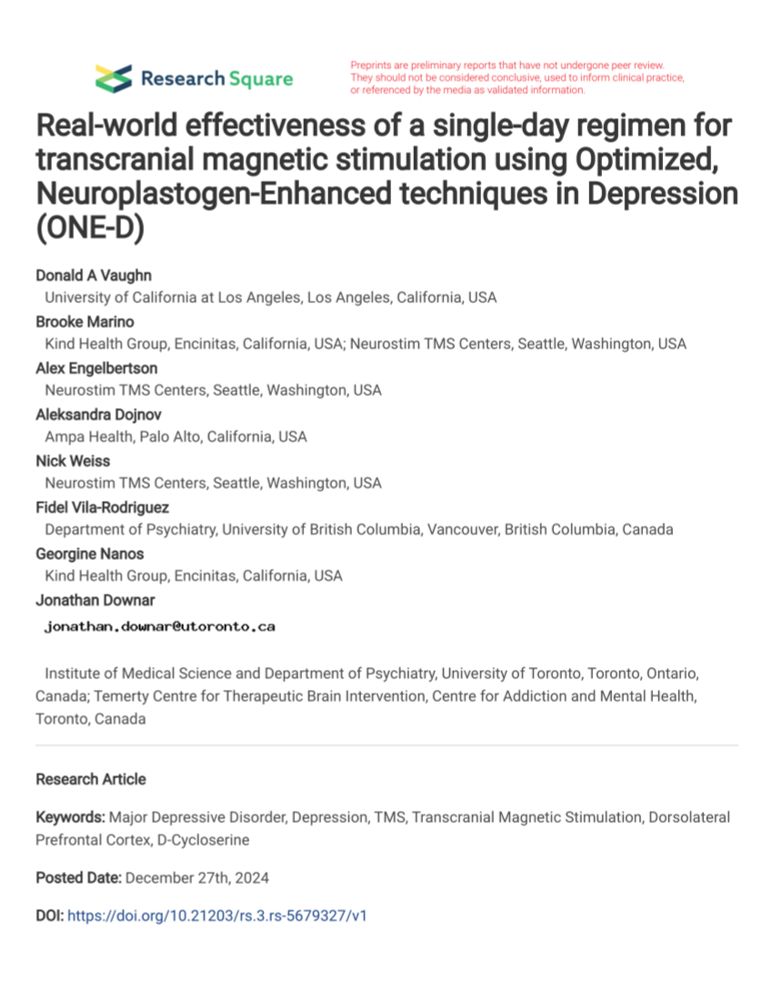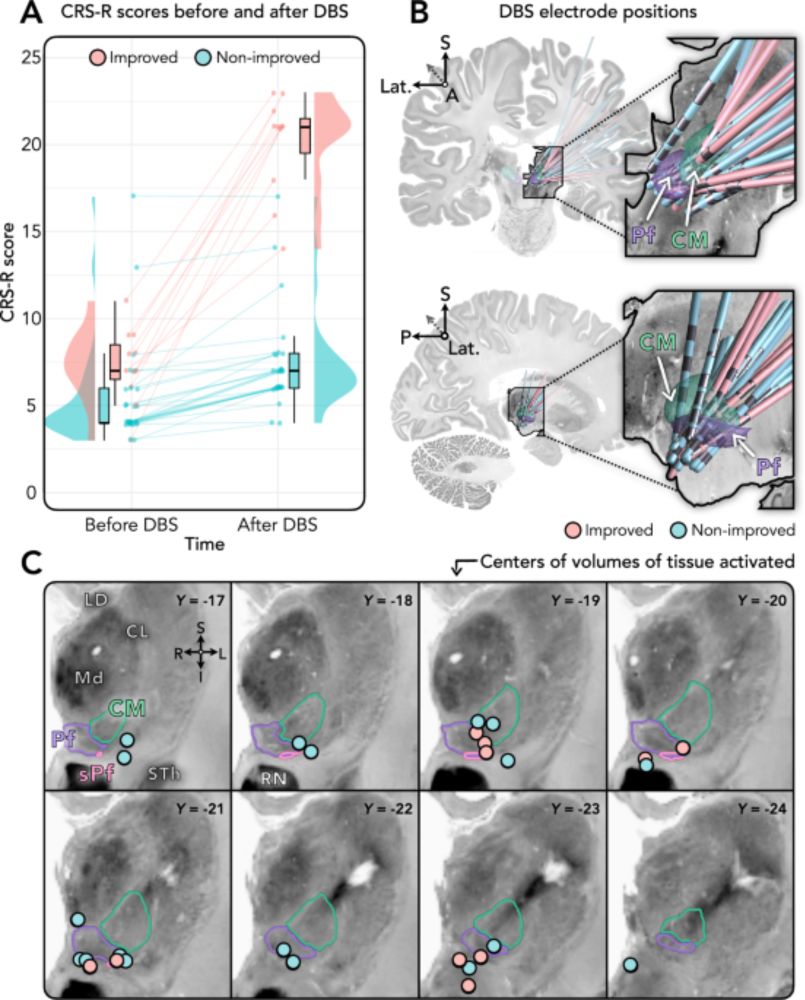
A human brain network linked to restoration of consciousness after deep brain stimulation - Nature Communications
In people with severe brain injuries, stimulation restored consciousness by engaging a deep brain circuit for wakefulness—revealing a target that may also guide treatment in stroke and epilepsy.
Just dropped in @natcomms.nature.com: we show that re-engaging a thalamic–ventral tegmental circuit with deep brain stimulation can reignite consciousness in patients with severe brain injury. Work led by Aaron Warren, with @andreashorn.org @foxmdphd.bsky.social @ others! tinyurl.com/4kz8j89b
21.07.2025 21:39 — 👍 24 🔁 18 💬 0 📌 2
Brani’s Stimupedia
30.07.2025 19:46 — 👍 1 🔁 0 💬 1 📌 0
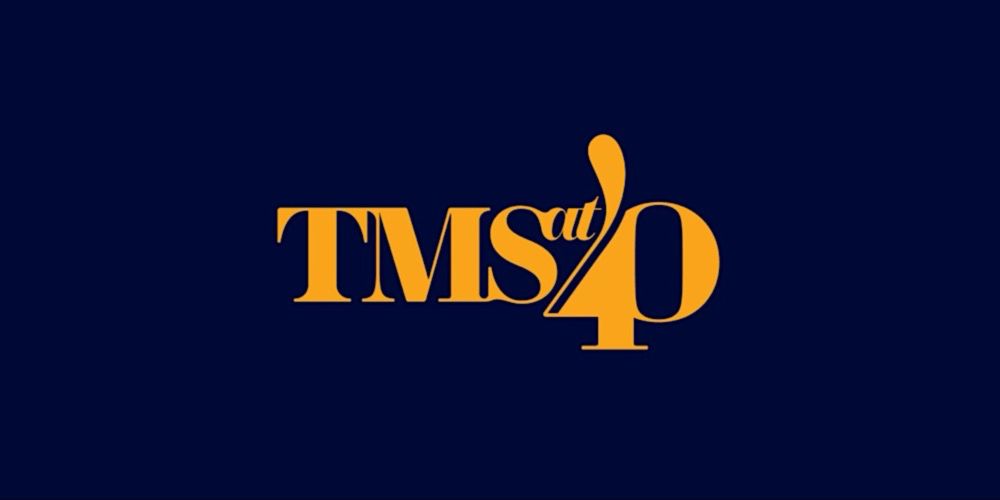
TMS at 40
Celebrating 40 Years of Innovation and Advancing Frontiers in Transcranial Magnetic Stimulation
🎉 40 Years of TMS: Registrations are now open!
We will be joined by experts in the field to reflect on four decades of progress and explore how TMS continues to push the boundaries of neuroscience, neuromodulation, and clinical practice.
➡️ Register Now: www.eventbrite.co.uk/e/tms-at-40-...
29.07.2025 11:15 — 👍 2 🔁 1 💬 0 📌 1
Brain rhythms in cognition -- controversies and future directions
Brain rhythms seem central to understanding the neurophysiological basis of human cognition. Yet, despite significant advances, key questions remain unresolved. In this comprehensive position paper, w...
/1 We took our sweet time (~3yrs) to put this into its final shape - but happy to say that the pre-print of an extensive review of brain rhythms in cognition - from a cognruro perspective - is now available. Please let us know what you think. #neuroskyence doi.org/10.48550/arX...
22.07.2025 12:31 — 👍 24 🔁 15 💬 1 📌 6
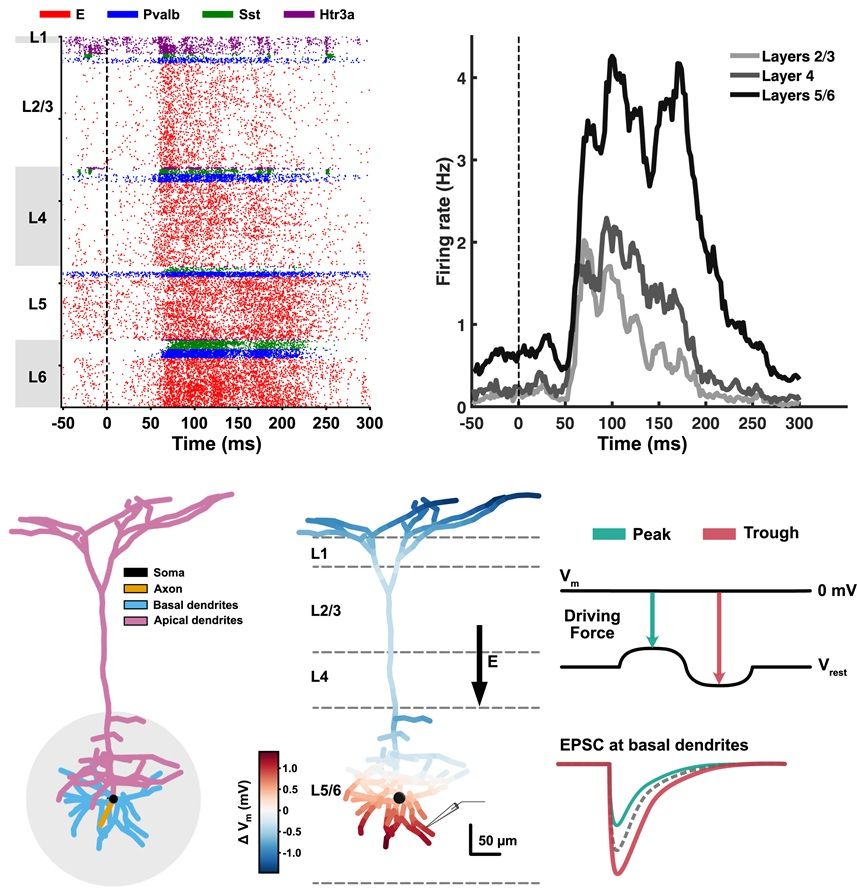
Top left: Raster plot showing the neural spiking of different types of neurons across layers. The red dots represent excitatory neurons, while the others represent parvalbumin-positive interneurons (blue), somatostatin-positive interneurons (green), and 5-HT3a receptor-positive interneurons (purple), respectively. Top right: Averaged firing rate of excitatory neurons across layers over time, calculated using a 2 ms time bin. Dash lines indicate the onset of flash stimuli. Bottom: Schematic illustration explaining the phase dependency. The synaptic input from the lateral geniculate nucleus (LGN) enters the region adjacent to basal dendrites in deeper layers (gray circle), which are highly responsive to this input (left). When the peak phase of AC flows in a downward direction (middle), the membrane potential in basal dendrites is depolarized, leading to a weaker driving force. It results in weaker (less negative) excitatory postsynaptic current (EPSC) affecting change in LFPs and vice versa during the trough phase.
Electrical #BrainStimulation can be used to modulate #brain activity but how does it affect the #CorticalLayers? This study shows that only the deeper layers show phase-dependent changes in local field potential components upon electrical stimulation @plosbiology.org 🧪 plos.io/406W3i5
09.07.2025 08:32 — 👍 12 🔁 3 💬 0 📌 0
Maximilian Lueckel, Suhas Vijayakumar, Til Ole Bergmann: PlanTUS: A heuristic tool for prospective planning of transcranial ultrasound transducer placements https://arxiv.org/abs/2506.22563 https://arxiv.org/pdf/2506.22563 https://arxiv.org/html/2506.22563
01.07.2025 06:47 — 👍 1 🔁 1 💬 0 📌 0
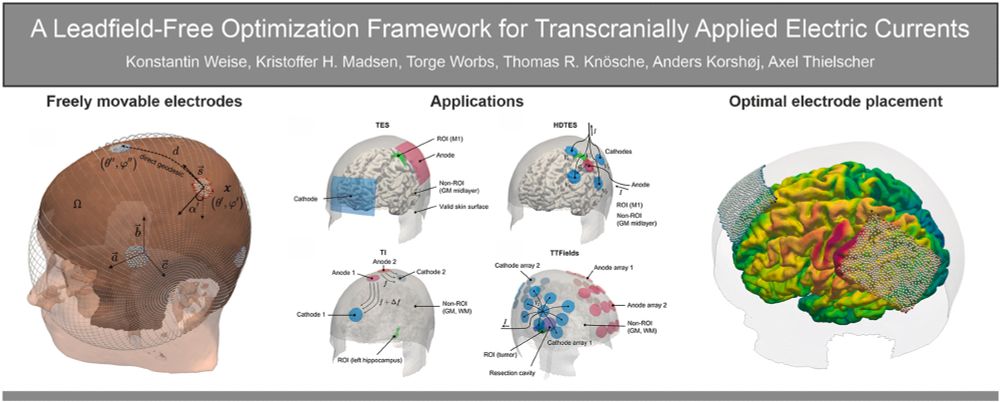
🚨 New paper alert from Weise et al.!
"A leadfield-free optimization framework for transcranially applied electric currents"
🔋 Optimize TES, TIS, ECT & TTFields without fixed leadfields
🧠 Electrode placement adapts to individual anatomy
💻 Now available in SimNIBS!
doi.org/10.1016/j.co...
02.07.2025 07:58 — 👍 8 🔁 5 💬 0 📌 0
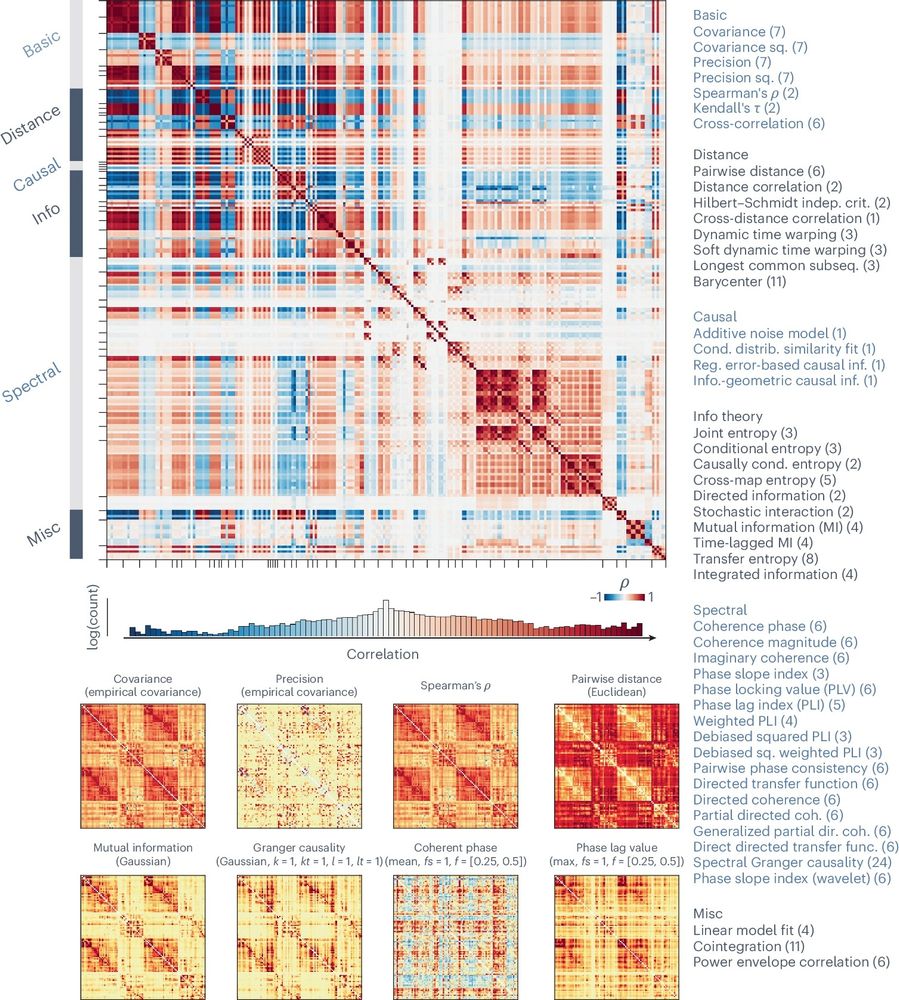
Benchmarking methods for mapping functional connectivity in the brain | doi.org/10.1038/s415...
What is the best measure of functional connectivity (FC)?
led by @zhenqi.bsky.social in @natmethods.nature.com ⤵️
20.06.2025 19:56 — 👍 89 🔁 44 💬 4 📌 3
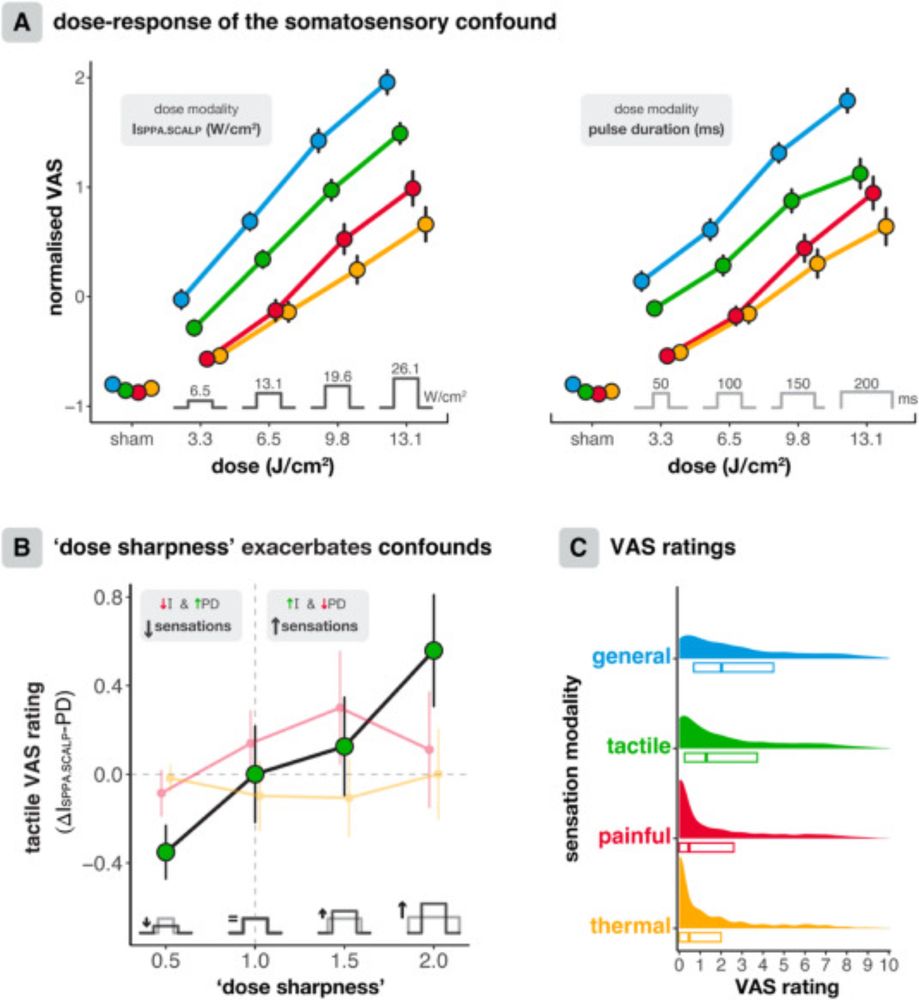
Parameter optimisation for mitigating somatosensory confounds during transcranial ultrasonic stimulation
Transcranial ultrasonic stimulation (TUS) redefines what is possible with non-invasive
neuromodulation by offering unparalleled spatial precision and flexible targeting
capabilities. However, peripher...
Hold on to your transducers, TUS community! We've focused on managing what participants can hear during stimulation… but how about what they feel?! Our BrainStim paper maps tactile, thermal, & painful sensations during transcranial ultrasonic stimulation - and reveals how to minimize them. Thread👇
19.06.2025 20:18 — 👍 6 🔁 1 💬 1 📌 0

The June 2025 cover of the Journal of Neurosurgery. The cover illustration depicts the clinical applications of high-frequency and low-frequency focused ultrasound (FUS) in the management of glioma. Art by Ken Probst.
On the cover of the Journal of Neurosurgery, Jacob Young, MD & Manish Aghi, MD, PhD, review the role of focused ultrasound (FUS) in treating gliomas, highlighting how low-frequency FUS can disrupt the blood-brain barrier to enhance drug delivery: thejns.org/view/journal... @ucsfcancer.bsky.social
04.06.2025 22:25 — 👍 5 🔁 4 💬 0 📌 0
Oscillatory impact of Transcranial Magnetic Stimulation at very weak-intensity on the primary motor cortex: A TMS-EEG study in the human brain https://www.biorxiv.org/content/10.1101/2025.02.04.636500v1
05.02.2025 21:15 — 👍 5 🔁 3 💬 0 📌 0
EPICURUS: E-field-based spatial filtering procedure for an accurate estimation of local EEG activity evoked by Transcranial Magnetic Stimulation https://www.biorxiv.org/content/10.1101/2025.02.16.638512v1
19.02.2025 10:15 — 👍 2 🔁 2 💬 0 📌 0
Want to optimize cerebellar TMS?
Our latest paper by @VridhiRohira & @CorominasXavier shows how to improve targeting precision. Don’t miss it! 👇
13.05.2025 21:13 — 👍 4 🔁 3 💬 0 📌 0
Functional Neurosurgeon
Brigham & Women's Hospital
Harvard Medical School
PI of #MENDLab
Hiring post-docs and research assistants—DM me!
Clinical neuroscientist, Postdoctoral Research Fellow at Harvard University and MGH, Neurology department.
Translational science investigating neuroplasticity and neuromodulation mechanisms to improve post-stroke aphasia and depression treatments.
Postdoctoral Research Fellow at the National University of Singapore (NUS)
Network Science enthusiast, in pursuit of computational neuroscience
https://sina-mansour.github.io/
Psychiatric neuroscientist (with capital Ψ, lowercase n)
| Causal mapper of @braincircuits.bsky.social
| Neuropsychiatrist
| Asst Prof @harvard.edu
| husband, father of a pure-bred Bengal cat and a 37.5% Bengal human
Professor at Stanford. Psychology/Neuroscience/Data Science. Books include: The New Mind Readers, Handbook of fMRI Data Analysis, Hard to Break, and Statistical Thinking.
https://poldrack.github.io/
Neuromodulator. TMS-fMRI has an extra special place in my heart.
Currently a Stanford Visiting Scholar in focused ultrasound and precision neurostimulation.
David M. & Tracy S. Holtzman Professor, Neurology @ WashU School of Medicine; precision neuroimaging, network plasticity, BWAS ≠ fMRI, action mode; #neuroscience #neurology #openscience #science
dosenbachlab.wustl.edu
🇰🇷🇨🇦 | Exploring cerebellum & therapeutic neuromodulation, one neuron at a time | DMRF Mahlon DeLong Awardee | Postdoc @SillitoeLab | @bcmhouston |🐈⬛☕️🚴🏻♀️🏕️⛳️
cognitive neuroscientist @ university of Tromsø
Bioinformatics Scientist / Next Generation Sequencing, Single Cell and Spatial Biology, Next Generation Proteomics, Liquid Biopsy, SynBio, Compute Acceleration in biotech // http://albertvilella.substack.com
Neuroscientist. Associate Professor at Juntendo University, Tokyo, Japan
https://researchmap.jp/takosada
Computational cognitive neuroscientist 🧠 | Former pro 🏀 | Calisthenics athlete 💪 |
@DJIGlobal Pilot 🚁 |
Post-Doctoral Research Fellow @StanfordBrain
Master’s Student at Université de Sherbrooke | Future Neuroscientist 🧠
PhD candidate (Tianjin University)
Neuromodulation: tACS/tDCS/otDCS
Psychiatric Disorders: Schizophrenia/MDD/BD/OCD/GAD
Unofficial bot by @vele.bsky.social w/ http://github.com/so-okada/bXiv https://arxiv.org/list/physics.bio-ph/new
List https://bsky.app/profile/vele.bsky.social/lists/3lim7ccweqo2j
ModList https://bsky.app/profile/vele.bsky.social/lists/3lim3qnexsw2g



